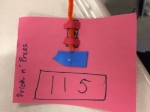Get creative and design #functionalfashion with free CAD programs
Leaf Chromatography
ESTIMATED COST:
$0.14
PER STUDENT
Required materials:
several leaves from different trees, small glass containers, rubbing alcohol, paper coffee filters, shallow aluminum pan, hot tap water, aluminum foil, scissors, tape, marker, sticky notes, plastic spoons
TED-Ed Description:
It's true that the cooler weather is a good indication that the seasons are changing, but there's no sign like the color of the leaves. In this lesson, you'll learn why leaves change color in the fall, and you'll learn how to do paper chromatography to separate the pigments found in a leaf.
NGSS alignment:
1. Asking questions (for science) and defining problems (for engineering) 3. Planning and carrying out investigations 6. Constructing explanations (for science) and designing solutions (for engineering) 7. Engaging in argument from evidence 8. Obtaining, evaluating, and communicating information
Adaptive Design Challenge
Suggested materials:
craft materials, i.e. masking (or scotch tape), string, chenille stems (pipe cleaners), markers, toothpicks, fastener strip (Velcro), construction paper
Description:
According to TryEngineering.org, engineers have developed products that help those with physical challenges lead more comfortable and independent lives. As shown in the videos below, adaptive designs not only help those in need, adaptive designs help everyone and make life better for all!
Tips:
Many craft, household or classroom items that you already have will work for this activity and can possibly be reused. Items listed here have already been tested with students as a part of this lesson. Students should be given access to as many or as few materials as you can afford. Allow students to be creative. I've done this activity with only toothpicks, markers and construction paper!
1. Asking questions (for science) and defining problems (for engineering) 2. Developing and using models 6. Constructing explanations (for science) and designing solutions (for engineering) 8. Obtaining, evaluating, and communicating information
Study Extreme Weather with a Dollar Store Barometer
ESTIMATED COST:
$0.07
PER STUDENT
Required materials:
jar or can, large balloon, rubber band, scissors, tape, stirring stick or straw, index card
Description:
A barometer is an instrument that measures air pressure, allowing weather forecasters and scientists to better predict extreme weather events. Actually, you don’t need to be a professional weather reporter to understand weather patterns. This easy to assemble barometer made from dollar store items can help!
Tips:
Craft, household or classroom items that you already have will work for this activity and can possibly be reused.
NGSS alignment:
2. Developing and using models 3. Planning and carrying out investigations 4. Analyzing and interpreting data 5. Using mathematics and computational thinking 6. Constructing explanations (for science) and designing solutions (for engineering) 8. Obtaining, evaluating, and communicating information
Paper Airplanes: Real-Life Algorithms
ESTIMATED COST:
$0.08
PER STUDENT
Required materials:
paper, scissors, glue
Code.org Description:
This lesson calls out ways we use algorithms in our daily lives, specifically making paper airplanes. This lesson also focuses on the bigger picture of computer science and how algorithms play an essential part.
NGSS alignment:
2. Developing and using models 4. Analyzing and interpreting data 5. Using mathematics and computational thinking 8. Obtaining, evaluating, and communicating information
Dollar Store STEM is back in action!
For the 2020-2021 school year, DSS is launching an A to Z lesson series.
Follow @dollarstorestem for updates: Instagram, Twitter.
Complete the activities, and post photos using the hashtag #dollarstorestem.
Electrifying STEM: Circuits and Batteries
ESTIMATED COST:
$0.07
PER STUDENT
Required materials:
"switches," wire strippers, insulated wire, flashlight, lightbulbs, batteries, electrical tape
Description:
TED-Ed calls batteries a "triumph of science." They allow electronics to operate "without anchoring us to an infernal tangle of power cables." The activities above take learners from simple circuits to an electrifying design challenge.
Tips:
Scissors may be used instead of wire strippers, but may take extra practice to strip the wire. Select a flashlight that can be easily disassembled so that the lightbulb can be removed. Also, replacing flashlights with lightbulbs may be more cost effective.
NGSS alignment:
1. Asking questions (for science) and defining problems (for engineering) 2. Developing and using models 6. Constructing explanations (for science) and designing solutions (for engineering) 8. Obtaining, evaluating, and communicating information








